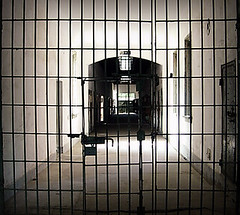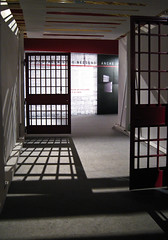
Prison Cell (Photo credit: danielkoehlersfotos)
When a mother is arrested, there is no specific public policy or routine process to coordinate what happens to her children, even immediately after childbirth. Many women in prison believe that separation from their children is the most difficult part of their punishment.
Although six percent of women are pregnant when they enter prison, most states make no special arrangements for the care of newborns. Pregnant inmates are often required to be shackled while giving birth, and after delivery mothers and babies are sometimes separated within a few hours. The infant is then sent to live with a family member or is placed in the foster care system.
Extended families usually assume childcare responsibilities, though many states don’t recognize family relations as legitimate foster care and deny them financial support and social services. Ten percent of children with mothers in prison are sent to foster homes, while the majority of these children live with grandparents. The Adoption and Safe Families Act of 1997 will certainly send even more children into foster care in the future, as it allows courts to terminate parental rights if a child is in foster care for 15 months out of any 22-month period.
Dana Simas, spokeswoman for the California Department of Corrections and Rehabilitation says:
Women who give birth in prison usually have to hand over their newborn to a relative or for adoption within 48 hours, or whenever the doctor releases her from the hospital.
That narrow window deprives new mothers of the option of breastfeeding their babies, says Karen van de Laat, the southern California regional director for Get on the Bus, a group that organized a special Mother’s Day visit to a women’s prison for 240 kids this year. She says:
Being able to hug your mom should be a right. Some of these kids would rather live here with their mom than go home. Most of the women in this prison are drug offenders or have been incarcerated for check or welfare fraud.
Nearly 900,000 youngsters in California have a parent in the criminal justice system, comprising nearly ten percent of California’s children.
A child’s chances of delinquency increase dramatically when visits to their incarcerated parents are denied. Kids with incarcerated mothers are more likely to wet their beds, do poorly in school and refuse to eat, studies show. These children often experience financial hardship, the shame and social stigma that prison carries, loss of emotional support and fear for their mother’s safety. Children with imprisoned parents are at increased risk for poor academic performance, truancy, dropping out of school, gang involvement, early pregnancy, drug abuse and delinquency. These at-risk kids are most often overlooked by mainstream children’s advocates.
The female prison population has exploded in the past 20 years, mainly due to mandatory-sentencing laws for drug offenses. Three times the number of women have been put behind bars in the last 10 years, over 75 percent of whom have children. Most of these inmates are young, unmarried women of color with few job skills and significant substance abuse problems.
According to a recent article, children of incarcerated parents differ from their peers in three main ways: inadequate quality of care, mainly due to poverty; lack of family support; and enduring childhood trauma.
Sadly, prisons are most often located in remote rural areas and are inaccessible to families without cars. An incarcerated woman is usually much further away from her home and is therefore much harder to visit, making the separation even more agonizing for both parent and child. Sixty percent of parents in California state prisons are held over 100 miles from their children, making visits impossible for many.
Too little attention has been paid to the plight of children with incarcerated parents, so too little is known about how to assist them. There is no procedure or policy to inquire about dependent children when a mother is arrested. If a child is persistently truant in school, there is no protocol to consider the disruption that maternal imprisonment causes at home. If a child is in the care of family services, too little about their emotional history is explored before they are placed in foster care. So there is a gap in policy and in routine communication between the public agencies established to protect all innocent children.
Fortunately, some states have begun to acknowledge the importance of mother-child relationships by introducing pioneering programs. In a few U.S. cities, the Girl Scouts Beyond Bars program brings mothers and daughters together in jail or prison, two Saturdays each month. Mothers spend supervised time working with their daughters on troop projects, and discuss issues such as avoiding drug abuse, coping with family crises and preventing teenage pregnancy.
Family Foundations, is a community-based residential drug treatment program based in Santa Fe Springs, California, where female inmates live in a converted school building with their children up to the age of six. The Mothers With Infants Together program allows eligible pregnant offenders to reside in a community-based program for two months prior to delivery and three months after delivery, thereby empowering women to participate in prenatal and postnatal programs on childbirth, parenting and family support skills programs.
The Mothers and Children Together program in St. Louis provides cost-free bus rides to prison four times a year for families without transportation. They also organize former inmates and volunteers to lobby at the state capital towards the improvement of visiting opportunities, and they hold support groups for recently released mothers, children and caregivers. New York’s Bedford Hills Correctional Facility opened the nation’s first nursery prison 100 years ago and continues to offer a range of services to inmates and their children, including a well-equipped playroom that is open all year. Run by Catholic Charities, it is designed to teach women parenting and life skills through classes and by allowing them to receive visits from their children as often as possible in a nurturing atmosphere. Only ten percent of women who successfully completed the program returned to prison, in contrast to 52 percent of inmates overall.
Inmates who do not receive child visits are six times more likely to be re-offenders. Simas says:
We encourage visiting and we try to make it as positive an experience as possible. We understand that family relationships are a big contribution to someone’s successful rehabilitation. Unfortunately, they are still incarcerated, so there are safety measures we need to follow, but we try to make it as family-friendly as possible.










































